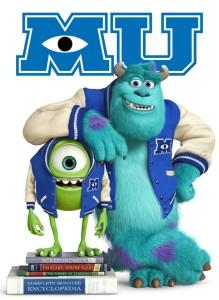 This is not a review of Pixar’s ‘Monsters University’ (MU), a fitting sequel to 2001 ‘Monsters, Inc.’, but a simple exercise to understand all about teamwork brilliantly conveyed through this film. Like every other animation film, MU is also made with the intention of entertaining audiences and it does achieve that besides providing an opportunity for us to learn about a team, its members and their behavior. If you’re bored to read about teamwork from your textbook in MBA, I strongly recommend this film.
This is not a review of Pixar’s ‘Monsters University’ (MU), a fitting sequel to 2001 ‘Monsters, Inc.’, but a simple exercise to understand all about teamwork brilliantly conveyed through this film. Like every other animation film, MU is also made with the intention of entertaining audiences and it does achieve that besides providing an opportunity for us to learn about a team, its members and their behavior. If you’re bored to read about teamwork from your textbook in MBA, I strongly recommend this film.
For the benefit of those who still haven’t watched MU, let me quickly explain the basic story-line. The film tracks the schooldays of Mike (aspiring scarer) and Sully (son of a top scarer) at MU, where they went from being worst enemies to best friends. Mike and Sully, who start off on the wrong foot, get expelled from the ‘Scaring Program’ due to an accident. To stay in the program, the duo should form a team (consisting of four more members) and win the ‘Scare Games’.
Regardless of the fun and frolic in MU, its soul lies in the relationship between Mike and Sully. Here’s what the film teaches us from the perspective of a team. To start with, let us define teamwork and try to relate it with some moments in the film.
Teamwork (from Wikipedia) is work done by several associates with each doing a part but all subordinating personal prominence to the efficiency of the whole. Teamwork processes fall into three categories – Transition Process, Action Process and Interpersonal Process.
Transition Process is further divided into Mission Analysis, Goal Specification and Strategy Formulation.
Mission Analysis: This includes ascertaining short and long term plans; identifying potential hazards and design tasks, plans and objectives related to the mission. Mike and Sully formed the team for personal reasons without even understanding the mission at hand. As a team, their short term plan was to win every event, while their long term plan was to eventually finish as the winner of the contest. It’s only after messing up in the first event, they realize that their potential hazard was not playing together as a team and letting individual differences influence them.
Goal Specification: Describes the desired goal state from different perspectives and allows members of a team to understand goals better. The goal of the team was to eventually win the contest by defeating remaining teams.
Strategy Formulation: Initially, the team didn’t have a strategy as Mike and Sully tried to kick the competitiveness out of each other. Defeating each other was more important for them than working together and winning. But all that changed after the first event as the team worked together to form a strategy.
Action Process is further divided into Monitoring Progress towards Goals, Team Monitoring and Coordination.
Monitoring Progress towards Goals: After they screw up for the first time, Mike revisits the goals and implements changes in the team. He rises as a leader and takes everybody under his wings and reinforces the bond between them.
Team Monitoring and Backup Behavior: In the second event of the ‘Scare Games’, each team using its tactical skills attempts to fetch a flag without being caught by the angry librarian. Sullivan, who tries to do it on his own, almost gets busted by the librarian but his team offers backup support in the nick of time to save him. Usually not all members are open to the idea of offering support to each other due to personal indifferences, so backup behavior calls for how to offer or accept backup support because it’s essential to win as a team.
Coordination: This can be simply defined as teamwork in implementation. It’s collecting resources, sharing information to enable each member to accomplish their part in support of a mutual objective. The best example is the relationship between Mike and Sully that went from worst to good in support of their common objective, which was to win the contest and continue their ‘scaring major’ degree.
Interpersonal Process is further divided into Conflict Management & Motivation and Confidence Building.
Conflict Management: Relationship between Mike and Sullivan suffered due to Affective conflict, which resulted in incompatibility between the two from the beginning. From ‘who is better than the other’ to ‘I will lead the team’ kind of stuff affected the overall performance of the team until they decide to call it a truce and work collaboratively.
Motivation and Confidence Building: When Mike’s team (Oozma Kappa) decides to quit midway after being booed by other teams, he takes them on a field trip to motivate them. The members of Oozma Kappa are ridiculed because they don’t have the looks of a typical monster. Mike takes them to Monstropolis, to prove that one doesn’t need the looks to be a scarer and that the best scarers use their differences to their advantages.
